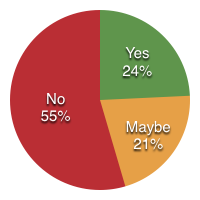Does @SavedYouAClick prove Betteridge’s Law?
A brief study of clickbait headlines 2014-07-14 #socialmedia
Betteridge’s law of headlines tells us how to interpret headlines that ask a question:
Any headline which ends in a question mark can be answered by the word no.
This tends to indicate sloppy journalism and happens to overlap with the tacky clickbait headlines that @SavedYouAClick tackles, so we can use this data to test the so-called law.
To test the effectiveness of Betteridge’s Law, I used All my tweets to load 307 tweets by @SavedYouAClick from 6 May - 30 Jun 2014. After filtering the list, I was left with 33 yes/no question headlines, with following breakdown of answers:

8 (24%) yes, 7 (21%) maybe, 18 (55%) no
As far as Betteridge’s Law is concerned, we can consider a ‘maybe’ to be equivalent to a ‘no’, as it is also a failure to affirm the claim that the headline weakly hinted at. These results therefore contradict Betteridge’s supposed law in 24% of cases.
Meanwhile, informal analysis of the tweets by @BetteridgesLaw reveals a collection of headlines where the answer is ‘no’ in all cases. This may, however, be due to prior selection.
In conclusion, and as Betteridge’s Law predicts, the answer to the question Does @SavedYouAClick prove Betteridge’s Law? is ‘no’, in this case. But it is right most of the time.

